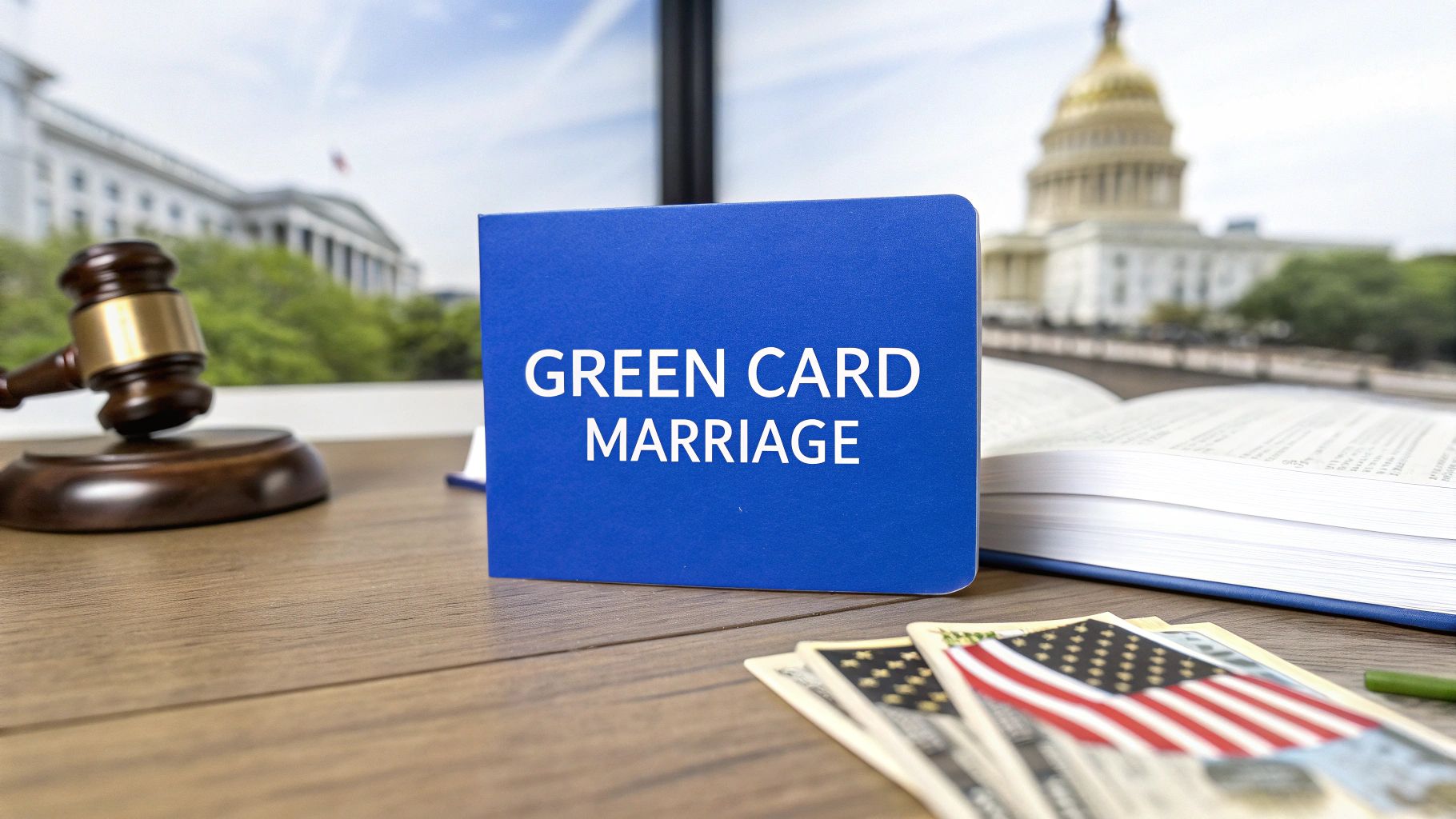Green Card Marriage: Your Path to U.S. Residency

Navigating the Green Card Marriage Landscape

The term “green card marriage” often carries a stigma. Many associate it with complexity and suspicion due to its potential for misuse. However, for many couples, a green card marriage represents a legal path to strengthen their commitment and establish a shared life in the United States. This section clarifies what a green card marriage entails and addresses common misunderstandings.
Defining Green Card Marriage
A green card marriage occurs when a foreign national marries a U.S. citizen or lawful permanent resident to obtain a green card. This provides them with lawful permanent resident status. The process involves proving to U.S. Citizenship and Immigration Services (USCIS) that the marriage is bona fide and not solely for immigration purposes. This can be difficult, as immigration officials carefully review these applications to identify potential marriage fraud.
Historical Context and Policy Influences
U.S. immigration policies have significantly shaped the concept of a “green card marriage.” For example, policy adjustments in the early 1990s made all mainland Chinese immigrants already in the U.S. eligible for green cards. This had a substantial impact on marital outcomes for these individuals.
Studies using 1990 and 2000 U.S. Census data show an increase in married Chinese immigrants following these policy changes. Highly educated Chinese immigrants often married spouses with higher education and income levels. Conversely, less-educated Chinese immigrants were more likely to marry U.S. natives. Learn more about this historical impact here. These past events reveal the connection between immigration policy and marital choices, which is vital for anyone navigating the green card marriage process today.
Legitimate Marriages vs. Red Flags
Differentiating a legitimate marriage from one that raises red flags is critical. Immigration authorities assess relationships based on various factors, including:
- Cohabitation: Living together is a significant indicator of a genuine relationship.
- Joint Finances: Shared bank accounts, assets, and financial responsibilities suggest a committed partnership.
- Family Ties: Interaction and acknowledgment of the relationship by both families provide further evidence of legitimacy.
- Shared Experiences: Photos, stories, and evidence of a life together help demonstrate the authenticity of the relationship.
Addressing Common Misconceptions
Many misconceptions exist around green card marriages. One common myth is that marrying a U.S. citizen automatically guarantees a green card. The reality is that the process is comprehensive, requiring extensive documentation and multiple interviews. Another misconception is that cultural differences hinder approval. While these differences can occasionally cause misunderstandings during interviews, they don’t disqualify a marriage based on genuine love and commitment.
Addressing these misconceptions early helps couples approach the process realistically and reduces unnecessary stress. Understanding the process, compiling the necessary documentation, and thoroughly preparing for interviews are vital steps for successfully navigating the green card marriage landscape.
Meeting Legal Requirements That Actually Matter

Securing a green card through marriage involves more than just a ceremony. It requires meeting specific legal requirements set by United States Citizenship and Immigration Services (USCIS) to demonstrate the authenticity of the marriage. This means providing compelling evidence that your relationship is genuine. This section explores these crucial requirements, offering insights into what constitutes a successful green card marriage application.
U.S. Citizen Vs. Permanent Resident Spouse: Key Differences
The process and requirements for a marriage-based green card vary depending on the sponsoring spouse’s immigration status. If your spouse is a U.S. citizen, the path is typically more straightforward. However, if your spouse is a permanent resident, the process is often more complex and involves longer waiting periods.
One key difference is the annual limit on green cards available for spouses of permanent residents. This cap can lead to significant processing delays. Understanding this key distinction early on can help you manage expectations and navigate the application timeline effectively.
Scrutiny For Recently Married Couples: What To Expect
Newly married couples should be prepared for increased scrutiny from USCIS. The agency’s primary concern is ensuring the marriage is not solely for immigration benefits. Therefore, you’ll need to provide strong evidence of a genuine, shared life together.
Helpful documentation includes joint financial accounts, lease agreements with both names, and shared utility bills. These items help establish the legitimacy of your relationship. Being proactive in gathering this documentation can help streamline the process.
Gathering Compelling Documentation: A Practical Guide
Just like planning for the transition from military to civilian life, applying for a green card through marriage requires careful preparation. A thorough understanding of the process is important, which you can further explore at Navigating the Military-to-Civilian Transition Journey. Comprehensive documentation is the foundation of a successful green card marriage application.
You’ll need to gather various official documents, including birth certificates, marriage certificates, and financial records. Supplementing these with personal items like photos, travel itineraries, and correspondence between you and your spouse can further illustrate your shared life and experiences. Organized documentation can help prevent processing delays and strengthen your case.
To help you understand the core requirements, we’ve created a table summarizing the necessary documentation:
Green Card Marriage Application Requirements:
Comprehensive overview of required documentation and eligibility criteria for marriage-based green card applications
| Requirement Type | For U.S. Citizen Spouse | For Permanent Resident Spouse | Notes |
|---|---|---|---|
| Form I-130, Petition for Alien Relative | Required | Required | Filed by the sponsoring spouse |
| Form I-485, Application to Register Permanent Residence or Adjust Status | Required if in the U.S. | Required if in the U.S. | Filed by the foreign spouse |
| Form DS-260, Immigrant Visa Electronic Application | Required if outside the U.S. | Required if outside the U.S. | Filed by the foreign spouse |
| Affidavit of Support (Form I-864) | Required | Required | Demonstrates financial ability to support the foreign spouse |
| Birth Certificates | Required | Required | Both spouses |
| Marriage Certificate | Required | Required | Official certificate |
| Financial Documents | Required | Required | Tax returns, pay stubs, bank statements |
| Proof of Bona Fide Marriage | Required | Required | Photos, joint leases, communication records |
| Medical Examination | Required | Required | Completed by a USCIS-approved physician |
| Biometrics Appointment | Required | Required | Fingerprints, photo, and signature |
This table provides a general overview. Consulting an immigration attorney can provide personalized guidance specific to your situation.
Meeting Financial Requirements: Proving You Can Support Yourselves
Financial stability is a critical aspect of the green card process. The sponsoring spouse must demonstrate the ability to support their partner financially and prevent them from becoming dependent on public assistance.
This typically involves submitting tax returns, pay stubs, and other financial documentation. In some cases, a joint sponsor may be needed to meet these income requirements. Understanding the financial obligations is a vital part of a successful application.
Navigating The Conditional Residency Period
If your marriage is less than two years old at the time of green card approval, you’ll receive conditional permanent residency, valid for two years. Before this period expires, you and your spouse must jointly file Form I-751, Petition to Remove Conditions on Residence.
This petition requires additional evidence of your ongoing bona fide marriage, including updated financial records, joint tax returns, and birth certificates of children born during the conditional period. This process reassures USCIS that your marriage is legitimate and not entered into solely for immigration purposes. How to master your US Visa application offers further insights. Failing to file this petition on time can lead to the termination of your residency and potential deportation.
Mastering the Green Card Marriage Interview

The green card marriage interview is a crucial step in the application process. It’s where the authenticity of your marriage is assessed. This section helps you prepare for this important interview, offering insights into what to expect and how to navigate it successfully.
Understanding The Interviewer’s Perspective
Immigration officers are trained to differentiate between genuine marriages and those entered into solely for immigration benefits. They use various techniques, including questioning and behavioral analysis, to evaluate the legitimacy of the relationship. Understanding their approach can boost your confidence going into the interview.
For example, officers may ask detailed questions about your daily lives, shared finances, and future plans. They’ll also observe your interactions and body language to assess your comfort level as a couple. Preparing for these specific areas is key to a positive interview experience.
Demonstrating A Genuine Relationship: Key Strategies
Showing a genuine and loving relationship is paramount. Sharing personal stories, photos, and anecdotes about your journey together can illustrate your shared life. This provides concrete evidence of your bond and its development over time.
Openly addressing any cultural differences or unique aspects of your relationship can also foster trust and transparency. Avoid over-rehearsing or creating a false narrative; authenticity is paramount.
Handling Challenging Questions: Tips And Best Practices
The interview may involve difficult questions designed to assess the depth of your connection. Questions about each other’s families, habits, or past experiences might feel intrusive. Preparing for these is essential.
- Practice answering open-ended questions: Discuss your relationship history and current dynamics.
- Be prepared to discuss financial matters: Be clear on how you handle finances jointly.
- Review your application materials: Ensure consistency between your spoken answers and the information in your application.
These practices can increase your confidence and enable you to respond honestly and convincingly.
Cultural Differences And Interview Perceptions
Cultural nuances can sometimes create misunderstandings during the interview. For instance, variations in physical affection or communication styles might be misinterpreted.
Addressing any potential cultural sensitivities upfront and explaining them to the officer can prevent these misinterpretations. This shows your awareness and proactive approach to a successful cross-cultural marriage. JapaChat offers further resources on cross-cultural relationships for Nigerians relocating abroad. Check out more here.
Practical Preparation Exercises
Preparing for the green card marriage interview is similar to studying for an exam. It demands focused effort and practical exercises. Many immigration attorneys suggest mock interviews to help clients practice responding to questions under pressure.
Reviewing your application together, discussing possible questions, and role-playing the interview can significantly increase your preparedness and confidence. This preparation is crucial for a successful interview and advancement in your green card process.
Understanding the Numbers Behind Green Card Marriages

This section explores the statistical realities of marriage-based green cards, offering a data-driven look at approval trends and key influencing factors. Understanding these numbers helps individuals set realistic expectations and prepare for the application process.
Decoding Green Card Marriage Approval Rates
While USCIS doesn’t publish specific data on “green card marriages,” we can gain valuable insights from overall marriage-based green card approvals. Historically, these approval rates have fluctuated, often influenced by policy changes and shifting enforcement priorities.
Factors such as the couple’s country of origin and age difference can also play a significant role. This information is particularly important for those considering this path to U.S. residency.
While precise data on ‘green card marriages’ isn’t always readily available, understanding national marriage trends offers a helpful context. The overall marriage rate in the U.S. varies considerably by state.
For instance, in 2022, Utah had one of the highest marriage rates, with approximately 43 marriages per 1,000 unmarried women. Conversely, New Mexico had one of the lowest, at about 21 marriages per 1,000 unmarried women. Access to a green card can indirectly influence these rates by providing increased legal stability. More detailed statistics can be found here. This data underscores the importance of looking beyond raw numbers and considering the wider social context.
To further understand approval rates and processing times, let’s examine some national statistics related to marriage-based green cards:
Marriage-Based Green Card Approval Statistics
| Category | Approval Rate | Average Processing Time | Common Denial Reasons |
|---|---|---|---|
| Immediate Relatives of U.S. Citizens | Generally High (Data not publicly broken down) | 6-12 months (varies) | Marriage fraud, lack of bona fide relationship evidence, incomplete documentation |
| Family-Sponsored Preference Categories | Varies based on visa availability and country of origin | Can take several years (varies) | Same as above, plus visa backlogs |
This table provides a general overview, and individual experiences can vary significantly. It’s essential to consult with an immigration attorney for personalized guidance.
Regional Variations and Processing Times
Processing times for green card applications can differ significantly across various USCIS service centers. Some centers handle higher caseloads than others, which can lead to extended processing times. This variation highlights the importance of patience and proactive case tracking throughout the process. Being aware of these potential delays is crucial for anyone planning their relocation to the U.S.
Policy Shifts and Their Impact on Approvals
Changes in immigration policies can significantly influence approval patterns. For example, heightened scrutiny of marriage-based applications can result in a greater number of requests for evidence and subsequently longer processing times. Staying informed about the latest policy updates is essential for navigating the application process effectively.
Demographic Insights and Approval Probabilities
Understanding broader demographic trends in immigration can provide valuable context for your application. Certain factors, such as the sponsoring spouse’s income level or the couple’s educational background, may influence the likelihood of approval. Analyzing these trends can offer a more nuanced perspective on the application landscape.
Recent Trends in Green Card Marriage Procedures
Recent trends indicate a growing emphasis on stricter documentation requirements and increased scrutiny of marriage-based green cards. This includes newer form editions, more stringent filing rules, and a heightened focus on preventing marriage fraud. Staying informed about these evolving requirements is key to avoiding application rejections or delays.
Avoiding The Marriage Fraud Minefield
Navigating the green card marriage process requires careful attention to avoid any appearance of marriage fraud. The consequences can be severe, ranging from application denial and permanent inadmissibility to criminal charges and even imprisonment. This section explores how genuine couples can protect themselves by understanding what triggers scrutiny from United States Citizenship and Immigration Services (USCIS).
Understanding USCIS Scrutiny
USCIS employs various methods to detect marriage fraud. These include:
- Social Media Monitoring: Officers may review social media profiles looking for inconsistencies in how the relationship is portrayed.
- Surprise Home Visits: Though less common, USCIS may conduct unannounced visits to assess living arrangements and evidence of a shared life.
- Community Informants: USCIS may receive tips from individuals alleging a fraudulent marriage.
- Inconsistent Financial Records: Discrepancies in joint accounts or financial documentation can raise red flags.
- Conflicting Interview Testimony: Different answers from spouses during the interview can trigger further investigation.
This detailed scrutiny is necessary to maintain the integrity of the immigration system. However, it’s crucial for legitimate couples to understand these measures. You might be interested in: Understanding Visa Rejection Reasons.
Red Flags Vs. Normal Relationship Variations
While certain inconsistencies are immediate red flags, normal variations in relationships don’t typically cause significant concern.
- Red Flag: Spouses providing vastly different accounts of their relationship history.
- Normal Variation: Minor discrepancies in recalling specific dates or events.
- Red Flag: Lack of a shared address or joint financial accounts.
- Normal Variation: Maintaining separate finances due to cultural norms or personal preferences.
- Red Flag: Inability to communicate in a shared language.
- Normal Variation: Reliance on a translator due to language barriers, but demonstrating strong non-verbal communication.
Understanding the difference between suspicious behavior and normal relationship dynamics can help couples prepare for the interview and address any potential concerns proactively.
Documenting Your Relationship Naturally
Genuine couples can safeguard their application by naturally documenting their relationship. This includes:
- Photos and Videos: Capture everyday moments and special occasions together.
- Joint Bills and Correspondence: Maintain records of shared expenses and official mail addressed to both spouses.
- Travel Itineraries and Tickets: Provide evidence of trips taken together.
- Communication Records: Retain phone logs, emails, and chat messages that demonstrate regular interaction.
- Affidavits From Family and Friends: Supporting statements from people who can attest to the legitimacy of the relationship add credibility.
These documents create a timeline of your relationship and provide concrete evidence of a shared life.
Addressing Unusual Circumstances
If your relationship has unique aspects, such as a significant age gap or previous marriages, address these proactively in your application. Providing clear explanations and supporting documentation can preemptively address any suspicion. Transparency is key.
Responding To Increased Scrutiny
If your case faces additional scrutiny, remain cooperative and composed. Provide any requested evidence promptly and truthfully. Consulting an immigration attorney is highly recommended to ensure your rights are protected and you navigate the process effectively. Thorough preparation and honest representation are key to a successful green card marriage application.
Thriving in Cross-Cultural Green Card Marriages
A green card marriage presents unique challenges, especially when couples are from different cultural backgrounds. Building a successful life together in the U.S. takes more than just legal paperwork. It requires understanding, respect, and a willingness to bridge cultural gaps. This section explores how couples can nurture their relationship while managing the stresses inherent in the immigration process. It’s crucial to protect yourself from potential pitfalls; follow these tips for avoiding scams and fraud.
Bridging Communication Differences
Communication is the cornerstone of any strong relationship. Cross-cultural marriages can introduce unique communication styles. One partner might communicate directly, while the other might be more indirect. Being mindful of these differences and actively working towards clear, respectful communication is essential. Learning a few key phrases in each other’s native language can be a meaningful gesture.
Navigating Family Expectations
Family plays a significant role in many cultures. Navigating the expectations of two families can be complicated. One family might prioritize frequent visits, while the other may value independence. Openly discussing these expectations and finding common ground that respects both families’ values is key to healthy relationships.
Building Mutual Understanding
A strong foundation requires mutual understanding and empathy. This involves learning about each other’s cultural background, traditions, and values. Trying new foods, celebrating each other’s holidays, or attending cultural events together can enrich this process. These shared experiences foster appreciation and strengthen the bond between partners.
Handling Finances, Parenting, and Social Integration
Practical aspects of life, such as finances, parenting styles, and social integration, can be influenced by cultural differences. One partner might be accustomed to joint finances, while the other may prefer separate accounts. Parenting approaches also vary widely across cultures. Openly discussing these differences and establishing shared approaches helps avoid conflict and promotes family unity. Actively supporting each other’s integration into the new community fosters a sense of belonging and reduces stress. You might also be interested in learning more about the EB-5 Visa for Nigerians.
Demonstrating Cultural Adaptation and Integration
Maintaining your individual cultural identity is important. However, demonstrating adaptation and integration into American culture can be beneficial to the green card process. This doesn’t mean abandoning your heritage. Rather, it involves showing a willingness to embrace your new environment. Learning English, participating in community activities, and engaging with American customs are some examples.
Supporting Each Other Through the Immigration Process
The immigration process can be long and stressful. Supporting each other emotionally, celebrating milestones, and maintaining open communication about the process are vital. This strengthens your relationship and reinforces your shared commitment to a future in the U.S.
By addressing these key aspects, couples in cross-cultural green card marriages can build a stronger, more resilient relationship that thrives amidst the challenges and opportunities of their new life together. Ready to begin your relocation journey? JapaChat, Nigeria’s AI-powered immigration expert, offers personalized guidance and support.

Leave a Reply